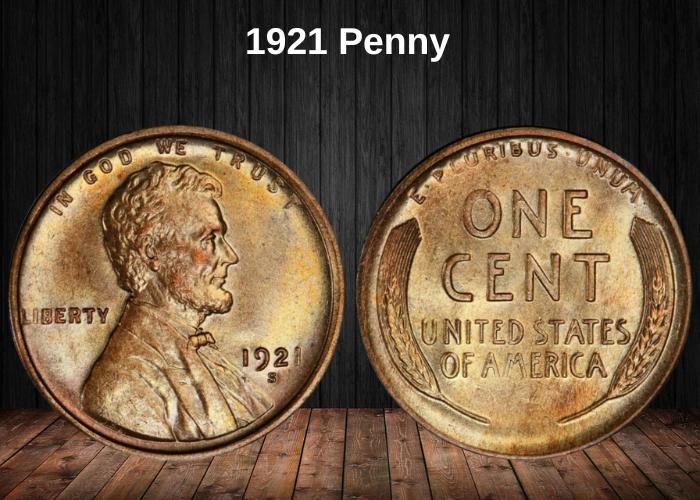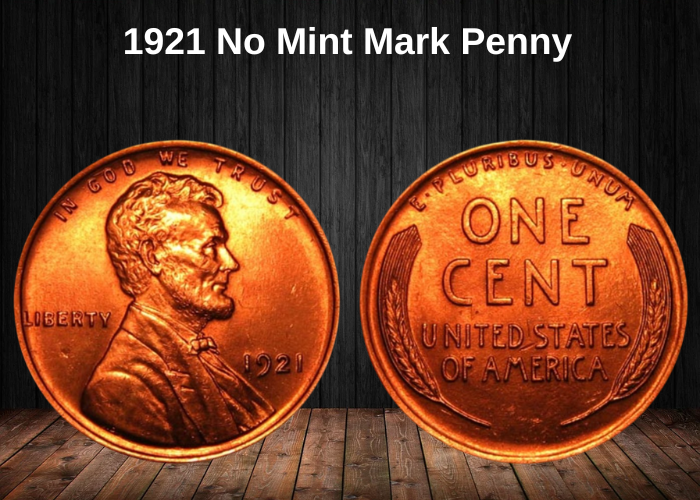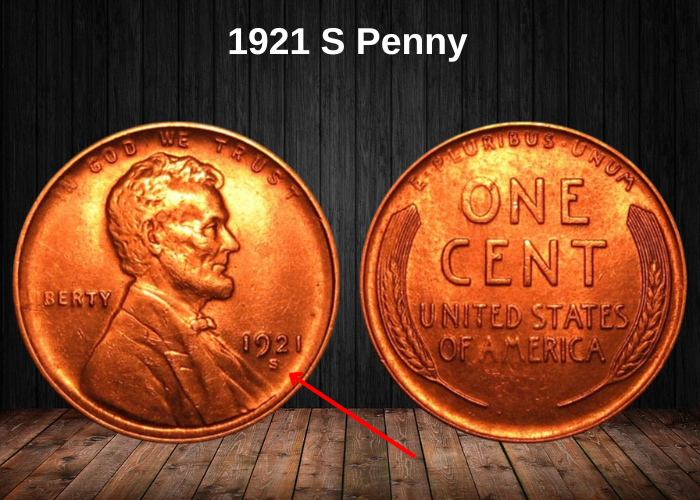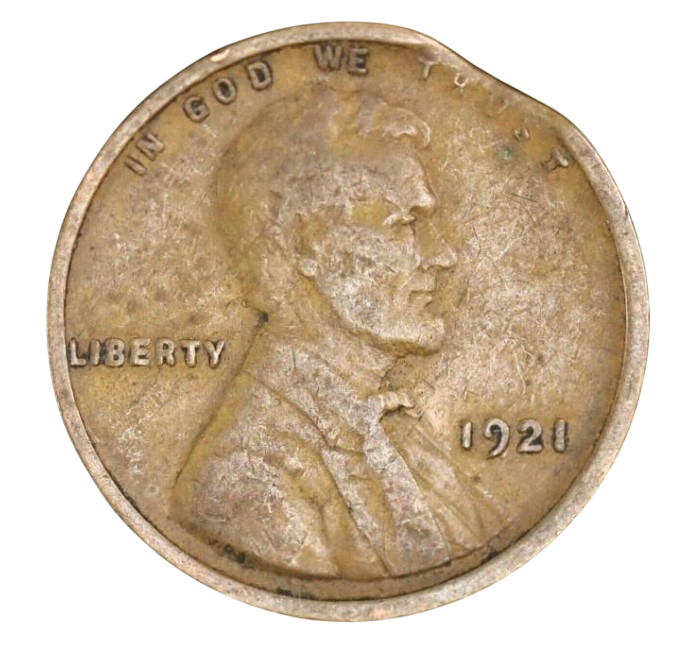
Do you have a 1921 penny in your coin collection? Have you ever wondered how much it’s worth?
Although it looks similar to modern-day cents, this 1921 Lincoln Wheat penny is highly valuable to collectors. Some pieces can be worth thousands of dollars, and rare varieties have sold for as much as $36,000. Pretty amazing, right?
While this coin doesn’t hold significant historical importance, its low mintage and distinctive design make it highly sought after by numismatics enthusiasts.
But before you rush to sell it, there are a few key factors you should know to ensure you get the best possible price.
In this guide, we’ll explore its history, market value, mint locations, and varieties, so you can uncover all the secrets of this 1921 Lincoln Wheat penny.
1921 Penny Value Chart
| Mint Mark | Good Condition | Fine Condition | Extremely Fine Condition | Uncirculated (MS65) |
|---|---|---|---|---|
| 1921 (No Mint Mark) | $0.59 | $1 | $15.50 | $155 |
| 1921 “S” | $2 | $4 | $45 | $850 |
Source: Standard pricing reference (Brown version).
1921 No Mint Mark Penny Value

After successfully redesigning the double eagle, eagle, half eagle, and quarter eagle coins in 1908, President Theodore Roosevelt turned his attention to the Indian Head penny.
For years, many Americans wanted a coin to honor Abraham Lincoln, the 16th president of the U.S.. However, this idea conflicted with a tradition dating back to 1789, which prohibited real people from appearing on regular U.S. circulating coinage. Despite opposition from traditionalists, Roosevelt was determined to commemorate Lincoln.
In late 1908, Roosevelt met with sculptor Victor David Brenner, known for designing the 1907 Lincoln Plaque and the Panama Canal Commission medal. While no official record of their conversation exists, many believe they discussed plans for a Lincoln coin. Later, Brenner submitted his designs, which Roosevelt approved.
In 1909, Mint Director Frank A. Leach hired Brenner to design the Lincoln Cent. Despite his concerns, Chief Engraver Charles Barber had no choice but to collaborate with him.
Brenner’s design featured a right-facing portrait of Lincoln on the obverse. To improve the composition, the Mint Director adjusted Lincoln’s position to center the image better. Above Lincoln’s head appeared “IN GOD WE TRUST”—the first time this motto was used on a U.S. cent. To the left was the word “LIBERTY”, while the year of minting (1921) was placed on the right.
The reverse of the Lincoln penny displayed two wheat stalks framing the inscriptions “UNITED STATES OF AMERICA” and “ONE CENT”. The Latin motto “E PLURIBUS UNUM” curved along the upper edge.
By 1921, the Lincoln penny had been in circulation for over a decade. That year, it was minted at Philadelphia and San Francisco, but not in Denver, as the Denver Mint focused on producing the Peace Dollar, a silver coin created to commemorate post-World War I peace.
The Philadelphia Mint struck 39,157,000 pennies in 1921, a significant drop compared to the previous year. This decrease was understandable, as the existing supply of Lincoln cents was already sufficient to meet demand.
1921 S Penny Value

Numismatists consider 1921 as one of the lowest mintage years for wheat pennies. Like the Philadelphia Mint, the San Francisco Mint also had low production, minting only 15,264,000 pennies, all marked with the “S” mint mark.
Although these coins are not extremely scarce, many exist in lower grades. Fully red gems from this year are very rare, though mint-state examples do exist.
Another interesting fact is that some 1921-S Lincoln cents have peculiarities. Since the mint used damaged dies during production, some pieces have poor strikes, while others have shallow mint marks punched close to the date. On worn coins, the mint marks are often invisible.
Due to their low mintage, most 1921-S pennies carry a higher premium. For example, coins graded as “Good” can sell for up to $2, which is $1.50 more than a Philadelphia penny of the same grade.
Well-preserved circulated pieces can cost double or even triple that price. According to NGC, a 1921-S penny in Fine condition is worth around $4. Coins with visible fine lines above the wheat stalks are more valuable, trading between $12.50 and $45.
Uncirculated examples with minimal contact marks and blemishes have a premium value ranging from $120 to $450. At Mint State 65, a 1921-S penny can be worth upwards of $850.
The rarest pieces are those that retain their original red mint luster and have no surface marks or scratches. These specimens can fetch between $700 and $13,500.
1921 Penny Grading
Without a doubt, the 1921 penny is a valuable specimen, especially in mint state condition. But the only way to discover the true value of your coin is through grading.
Most people use reputable third-party grading services, like PCGS, NGC, and ICG, to get their coins graded and authenticated. The higher the grade, the more money collectors are willing to pay.
Although you might need the help of a grading company to properly evaluate your 1921 penny, one of the most widely accepted grading systems is the Sheldon System. Developed in 1949 by Numismatic Dr. William Sheldon, this system assesses a coin’s luster and strike and then assigns a grade from 1 to 70.
Here is an outline of the 1921 penny grades and what they mean.
Good
A good grade typically means the 1921 penny has spent years in circulation. As a result, it shows signs of heavy wear and damage on the surface. From deep scratches to distracting contact marks, it’s clear the penny changed hands frequently over a long period.
Nevertheless, the outline of some design elements remains visible. The same applies to the date and lettering, though they might seem slightly smoothed out.
In the portrait, expect to see details on Lincoln’s coat and the upper part of his hair. On the reverse, the coin will also retain some details, i.e., the grains of wheat might still be visible.
Fine
Wheat pennies with a fine grade have been in circulation for a significant amount of time, yet they still retain their overall condition. However, they are not without blemishes or scratches. You may also notice some wear on the edges.
Key design features such as Lincoln’s coat and lapel may show slight flattening. The inscriptions, including Liberty and In God We Trust, will still be distinct and legible. These Lincoln cents maintain an aesthetic appeal.
Extremely fine
An extremely fine 1921 penny has spent minimal time in circulation, showing only moderate to slight wear on the high points of the coin.
Lincoln’s head may display a slight flatness, but all details, including his hair and face, are still visible and well-preserved. Additionally, the major design elements remain bold and clear.
Overall, the penny appears almost perfect and visually appealing.
Uncirculated
An uncirculated or mint state 1921 penny has never been in circulation, so it remains free from wear and retains its original bright red color or brassy luster.
However, minor abrasions, scratches, and contact marks may be present, especially on Lincoln’s hair or the wheat ears. These imperfections are typically only noticeable under magnification or when the coin is tilted under light.
Uncirculated Lincoln cents are often beautifully toned and have exceptional eye appeal, which is a key factor in coin grading.
Rare 1921 Penny Error List
1921 Penny Off-center Error

As the name suggests, an off-center error is a minting mistake where the penny’s design (on one side or both) is not symmetrically aligned with the center. Instead of having a balanced, centered design, the image of Lincoln or wheat stalks appears off-kilter.
This error occurs when the punching machine does not align properly with the coin during minting, causing the design to be struck off-center. This results in a section of the coin being left blank. Depending on how far off-center the design is, an off-center wheat penny can be worth a significant amount.
1921 Penny Broadstrike Error
Have you ever come across a Lincoln wheat penny that seems flattened or stretched out in an unusual way? There’s a good chance it might be a Broadstrike error.
During minting, the coin is typically held in place by a retaining collar to prevent its edges from spreading out too far. However, if the coin is struck without this collar, it can come out thinner and appear distorted. In some cases, the design may even partially or completely go off the edge of the coin. But collectors usually prefer coins with a complete or clear design.
If you find a 1921 penny with this error, it could potentially be worth a significant amount of money. So, be on the lookout for any misshapen or wonky-looking pennies!
1921 Penny Clipped Planchet Error

A clipped planchet error refers to a coin with a flat, crescent-like edge. This error happens when the cutting machine accidentally clips off a portion of the blank planchet used to create the coin before it’s stamped. As a result, the coin ends up with a section of its edge missing.
Coins with a clipped planchet error can be worth more than their metal value, especially if the coin is in mint state and the error is rare. So, keep an eye out for any pennies with an unusual edge!
Where to sell your penny?
Now that you know the value of your penny, you might be wondering where to sell it. Don’t worry: here’s a guide to some of the best online platforms where you can easily sell your coins, along with their advantages and disadvantages.
Discover the best platforms for selling coins online (pros and cons).
1921 Penny FAQs
Q1: What is the 1921 Penny?
The 1921 Penny is a British one-penny coin that was issued in 1921. It was part of the series of coins that featured the image of King George V on the obverse and Britannia on the reverse.
Q2: What is the significance of the 1921 Penny?
The 1921 Penny is considered significant because it was minted during a period of economic turmoil, including the aftermath of World War I. It is also notable for its design, which features the famous Britannia figure on the reverse, a symbol of British strength and unity.
Q3: How much is a 1921 Penny worth?
The value of a 1921 Penny can vary depending on its condition. A well-preserved, uncirculated coin may fetch higher prices, while coins with heavy wear or damage may be worth less. On average, prices for a 1921 Penny range from $1 to $10 for lower grades, but they can be worth much more for higher-grade examples or rare varieties.
Q4: What is the design of the 1921 Penny?
The 1921 Penny features an image of Britannia seated on the reverse side, holding a trident and shield, with a ship in the background. The obverse side has a portrait of King George V, designed by Sir Edgar Bertram MacKennal. The inscriptions on the coin include “GEORGE V” and “BRITT: OMN: REX F.D. IND: IMP” (King of all Britons, Defender of the Faith, Emperor of India).
Q5: How rare is the 1921 Penny?
The 1921 Penny is not considered extremely rare, as it was produced in relatively large quantities. However, certain varieties or those in exceptional condition can be harder to find and may be considered rare among collectors.
Q6: How can I identify a 1921 Penny?
To identify a 1921 Penny, look for the year “1921” inscribed on the coin’s reverse. The obverse should have a portrait of King George V, and the reverse will feature Britannia seated with a trident and shield. The coin has a diameter of 30.81mm and weighs 9.45g.
Q7: What is the metal composition of the 1921 Penny?
The 1921 Penny is made of bronze, composed of 95% copper, 4% tin, and 1% zinc. This composition was common for British pennies at the time.
Q8: Where was the 1921 Penny minted?
The 1921 Penny was minted at the Royal Mint in London, although coins of this era were also sometimes produced at branches of the Royal Mint in other locations, such as the Heaton Mint in Birmingham.
Q9: Are there any valuable errors in the 1921 Penny?
As with many coins, there may be examples of the 1921 Penny with minting errors, such as misprints or die variations. These can increase the value of the coin significantly. A common error in many pennies from this era includes off-center strikes or double dies.
Q10: Can I find a 1921 Penny in circulation today?
It is highly unlikely to find a 1921 Penny in general circulation today due to its age. Most 1921 Pennies are now kept by collectors or stored in private collections. However, it is still possible to find them through numismatic dealers, auctions, or as part of a personal collection.



















































